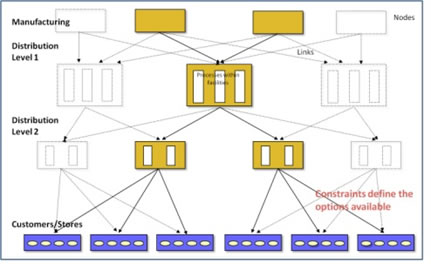|
We consider that today's increasingly complex business environment demands sophisticated tools to support any change in strategy. The key supply chain decision support tools used and supported by Carpenter Ellis are:
- Network Optimisation Modelling
- Inventory Optimisation, and
- Simulation
We also work with partners that use the most advanced business intelligence tools for unique and complex problems where standard tools are inappropriate.
Even when the most sophisticated tools are not warranted, most examinations of a supply chain require high levels of analytics to identify and interpret the key patterns of activity, and Carpenter Ellis has used analytical techniques for most of the clients that we have assisted. 
The most significant decisions made in most supply chains are those concerning the physical network that supports the flow of product from supplier to consumer and the network optimisation models that have been developed to support these decisions are one of the great success stories of the last 20 years. Most network modelling projects achieve first time savings of 5-20% of total operating cost,(or an equally significant margin impact from improved ability to deliver service) and these models have been at the heart of many of the major supply chain transformations that have received publicity in the last 5 years.
We consider that for most supply chains network modelling is a highly effective tool to support quantum change, and believe it should be used in any major strategy re-examination.
Network models are mathematical models which take account of the supply chain's activities, costs, capacities and constraints to enable the least cost network to be developed. They are used to address questions such as the number and location of manufacturing or distribution facilities to support a particular service level. They are especially important for merger planning, managing growth or reducing the overall cost structure of the business.
The more advanced modelling projects can also take account of revenue and pricing dynamics to provide a very sophisticated tool for considering, not only cost structure issues, but broader business decisions such as channel strategy; product mix and market allocation decisions for a scarce resource (e.g. timber); and for market entry or exit decisions.
Network modelling is also particularly applicable to support decision making on emission strategies . Carbon emissions can be included in a model and the cost of different strategies with and without a cost on carbon can be evaluated in conjunction with other supply chain strategies , rather than in isolation from the core business.
Carpenter Ellis and its principals and associates have been involved in many ground-breaking supply chain network designs modelling projects in Australia and Asia including:
- Paint distribution in China – models of alternative service level/cost scenarios over 2 and 5 year timeframes (as infrastructure changes in China)
- Construction materials in Australia – development of distribution network, including trade supply retail network
- Mass merchandising retail in Australia – development of distribution network and channel selection tool by category
- Department store in Australia – distribution network strategy
- Paint manufacturer in Australia – manufacturing and distribution strategy to integrate acquisitions.
|
